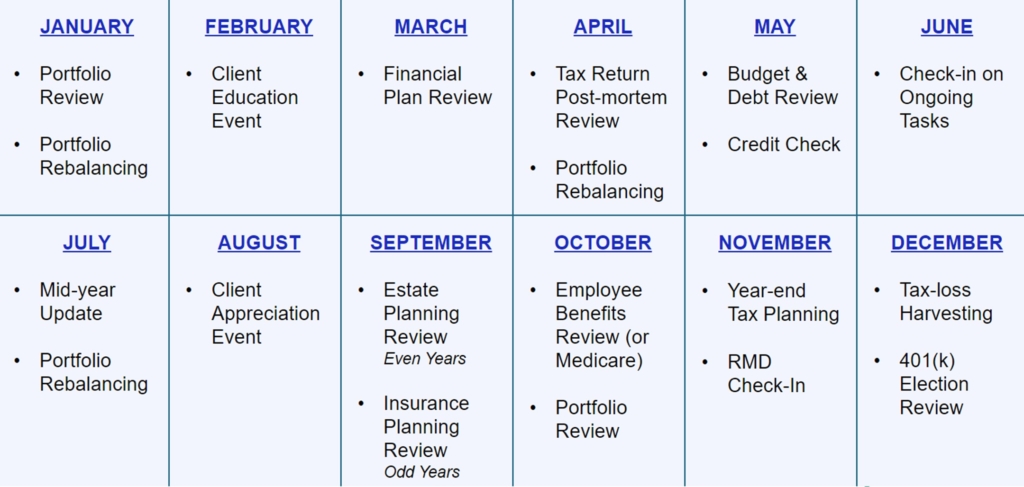Why Teaching Clients May Be Your Most Strategic Asset in 2026
Many financial professionals see the annual calendar change as a time to look for future opportunities. For forward-thinking financial planners… Read More

Insights and best practices for successful financial planning engagement
• Joe Buhrmann • December 26, 2023

Do your clients understand the full value of the services you are providing them? As a financial professional, being able to communicate what your clients are getting for their fees is crucial for both acquisition and retention.
Structuring your services based on a calendar makes it easy to present your services to prospective clients and demonstrate the ongoing value you are providing to your existing clients. If your prospects and clients can see exactly how you will take care of their finances throughout the year, you can confidently justify the value of your financial planning services to them.
A well-constructed client service calendar will also help you run your business more smoothly. By addressing your firm’s work in a systematic way, you will ensure that no task falls through the cracks. Your client experience will be improved through the increased consistency, accountability, and productivity that utilizing a client calendar provides.
If you are looking to create a client service calendar for the first time, here are five steps you can take to go from a blank page to a calendar that showcases what you do for your clients.
Start by making a list of the services you offer to your clients and the key deliverables you prepare for them. This may include investment-related activities, financial planning tasks, performance reports, and your typical cadence of client meetings.
Don’t forget to include the “behind the scenes” activities that you complete. There is a large amount of work that your client doesn’t see you do and may not even be aware of, such as tax-loss harvesting or portfolio rebalancing. By including that work in your service calendar, you can better showcase the value you are providing to your clients.
Are there are any gaps in your service offering that you would like to fill? Think about the client experience that you want to provide and consider what clients want from their financial advisor. While nearly all advisors are offering retirement and investment planning, clients have financial questions that go beyond those two areas. Expanding your service offerings and engaging in holistic financial planning could help you better meet your clients’ needs. If you are ready to expand into additional services, now is the time to start thinking about how you can incorporate them into your practice.
Are there other client touch points you need to account for beyond your planning services? If you send regular email newsletters, hold educational seminars, and/or host client appreciation events, including them in your calendar will help ensure they don’t fall through the cracks and get forgotten.
Now that you have a list of everything you want to include in your service calendar, start mapping out what your team will do when. Take the biggest, most important tasks and services on your list and add those to your calendar in the places that make the most sense for your business and your clients. Once those are scheduled, fill in the empty spaces around them with the remaining items on your list.
As you fill in the calendar, consider the natural times when a certain task or discussion around a specific topic could be held. For example, September could be a good time for a college funding conversation, because the kids have just gone back to school and their parents will be thinking about how they’re going to be shipping them off to college soon.
In addition, keep in mind that not every service has to be done on an annual basis. Some can be done every other year. For example, you could plan to do estate planning on even years and insurance planning on odd years.
If you have implemented a tiered service model in your practice, create a different service calendar for each of your client tiers that aligns with the level of service you provide for them. If your “A” clients get monthly touch points while your “B” clients get quarterly touch points, you want that to be reflected in your calendar to show the value you are offering to each client tier.
When you are ready to implement your new client service calendar, start by sitting down with your staff and reviewing it with them. One of the benefits of using a service calendar is that it allows you to provide a consistent client experience, which means that everyone on your team needs to understand how their work fits in.
After you have finalized the service calendar with your team, you can share it with your clients. Consider reviewing it with each of them at your next meeting. This will set their expectations for the future and remind them of the ongoing value that you are providing to them. It will also help reduce questions from your clients about what services you provide and when they can expect to work with you on the different aspects of their financial plan in the future.
With both your team and your clients aligned on your service calendar, it is ready to be put to use. Your service calendar will be the guide you use going forward as you work with all of your clients. However, it is also important to remember to be adaptable. Events like tax and legislative changes or changes in your clients’ individual circumstances may require you to evolve your calendar to best meet their needs.
If you ask 100 advisors for their service calendars, you will probably get 100 different service calendars of varying duration and detail. While no firm’s service calendar will look exactly alike, here is an example of what a basic financial advisor service calendar might look like. You can use this sample as a starting point or inspiration for a calendar that is tied to your firm’s specific offerings.

Developing a client service calendar and setting expectations with your clients is just the start. Once you have set the expectations by sharing your new calendar, you need to ensure that you deliver on them. When your clients see that their experience aligns with the service calendar you have presented to them, it will build their trust in you and make them more confident in the value they are getting for what they pay.
While your service calendar will set the stage for your ongoing relationship with your clients, it does not include an important part of your relationship with new clients: onboarding. Getting a new client acquainted with your services and taking in their information can be a labor-intensive process, but it doesn’t have to be. Digitizing your onboarding process will help ensure it goes smoothly so that you can quickly transition clients into the cadence of your service calendar.
DISCLAIMER: The eMoney Advisor Blog is meant as an educational and informative resource for financial professionals and individuals alike. It is not meant to be, and should not be taken as financial, legal, tax or other professional advice. Those seeking professional advice may do so by consulting with a professional advisor. eMoney Advisor will not be liable for any actions you may take based on the content of this blog.
You may also be interested in...
Many financial professionals see the annual calendar change as a time to look for future opportunities. For forward-thinking financial planners… Read More
For the last 13 years of my career, I’ve spent a lot of my time working with and coaching financial… Read More
Financial planning in today’s world increasingly relies on technology and using digital tools to enhance the role of a financial… Read More
Download this eBook now and learn how AI is expected to impact the industry.
Download Nowa new source of expert insights for financial professionals.
Get StartedTips specific to the eMoney platform can be found in
the eMoney application, under Help, eMoney Advisor Blog.